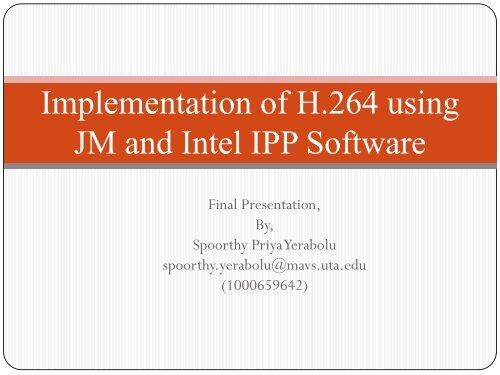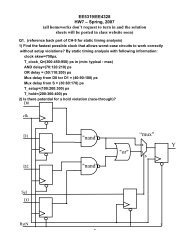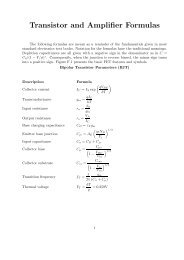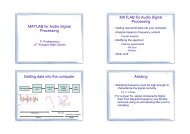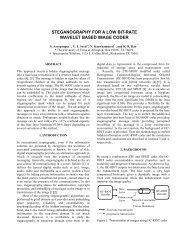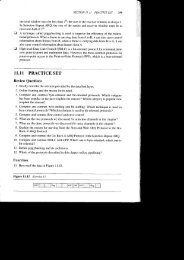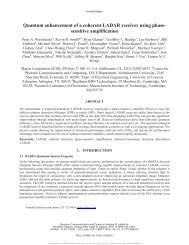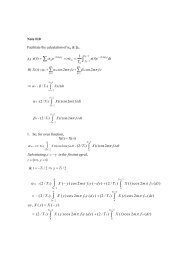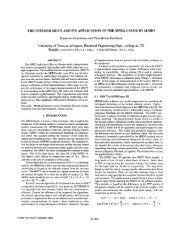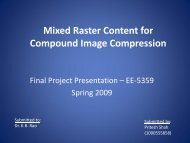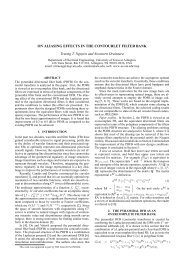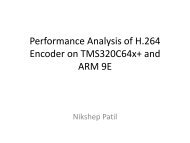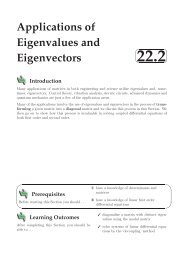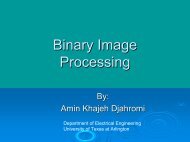Implementation of H.264 using JM and Intel IPP Software
Implementation of H.264 using JM and Intel IPP Software
Implementation of H.264 using JM and Intel IPP Software
You also want an ePaper? Increase the reach of your titles
YUMPU automatically turns print PDFs into web optimized ePapers that Google loves.
<strong>Implementation</strong> <strong>of</strong> <strong>H.264</strong> <strong>using</strong><br />
<strong>JM</strong> <strong>and</strong> <strong>Intel</strong> <strong>IPP</strong> S<strong>of</strong>tware<br />
Final Presentation,<br />
By,<br />
Spoorthy Priya Yerabolu<br />
spoorthy.yerabolu@mavs.uta.edu<br />
(1000659642)
Goal<br />
The main aim <strong>of</strong> this project is to study <strong>and</strong> implement<br />
different pr<strong>of</strong>iles <strong>of</strong> <strong>H.264</strong> [1].<br />
Comparison is done based on metrics like MSE (Mean<br />
Square Error), PSNR (Peak – to- Peak Signal to Noise Ratio),<br />
SSIM (Structural Similarity Index Metric), encoding time,<br />
decoding time <strong>and</strong> the compression ratio <strong>of</strong> the <strong>H.264</strong> file<br />
size (encoded output).<br />
Various test sequences in different formats like CIF<br />
(Common Intermediate Format), QCIF (Quarter Common<br />
Intermediate Format) <strong>and</strong> SD/HD are used.<br />
S<strong>of</strong>twares used <strong>JM</strong> 17.2 [13] <strong>and</strong> <strong>Intel</strong> <strong>IPP</strong> 6.1 [14].
<strong>H.264</strong>/AVC/MPEG-4 Part 10<br />
<strong>H.264</strong> is a block-oriented motion compensation based codec.<br />
It is most commonly used formats for the recording,<br />
compression <strong>and</strong> distribution <strong>of</strong> high definition video.<br />
One <strong>of</strong> the codec st<strong>and</strong>ards for blue-ray discs.<br />
It provides variable block-size motion compensation<br />
(VBSMC) with block sizes as large as 16 x 16 <strong>and</strong> as small as<br />
4x4.<br />
Layered structure:<br />
Network abstraction layer (NAL)<br />
Video coding layer (VCL)
Variable Block Sizes<br />
Figure 1: Variable block sizes for motion estimation <strong>and</strong> motion compensation [3].
<strong>H.264</strong> Pr<strong>of</strong>iles<br />
The st<strong>and</strong>ard sets 17 different pr<strong>of</strong>iles which target specific classes<br />
<strong>of</strong> applications.<br />
Constrained Baseline Pr<strong>of</strong>ile (CBP)<br />
Baseline Pr<strong>of</strong>ile (BP)<br />
Main Pr<strong>of</strong>ile (MP)<br />
Extended Pr<strong>of</strong>ile (XP)<br />
High Pr<strong>of</strong>ile (HiP)<br />
High 10 Pr<strong>of</strong>ile (Hi10P)<br />
High 4:2:2 Pr<strong>of</strong>ile (Hi422P)<br />
High 4:4:4 Predictive Pr<strong>of</strong>ile (Hi444PP)<br />
High 10 Intra Pr<strong>of</strong>ile<br />
High 4:2:2 Intra Pr<strong>of</strong>ile
High 4:4:4 Intra Pr<strong>of</strong>ile<br />
CAVLC 4:4:4 Intra Pr<strong>of</strong>ile<br />
Scalable Baseline Pr<strong>of</strong>ile<br />
Scalable High Pr<strong>of</strong>ile<br />
Scalable High Intra Pr<strong>of</strong>ile<br />
Stereo High Pr<strong>of</strong>ile<br />
Multiview High Pr<strong>of</strong>ile<br />
<strong>H.264</strong> Pr<strong>of</strong>iles….
Figure 2: Pr<strong>of</strong>iles in <strong>H.264</strong>/AVC [5].
Table 1: Specific applications for each pr<strong>of</strong>ile [6].
<strong>H.264</strong> Encoder<br />
Figure 3. Coding Structure for <strong>H.264</strong> encoder [3].
<strong>H.264</strong> Decoder<br />
Figure 4. <strong>H.264</strong> decoder block diagram [3].
Video Formats<br />
Format Luminance resolution (horiz x vert.) Bits per frame (4:2:0, 8 bits per<br />
Sub – QCIF<br />
Quarter CIF (QCIF)<br />
CIF<br />
4CIF<br />
SD<br />
128 x 96<br />
176 x 144<br />
352 x 288<br />
704 x 576<br />
720x480<br />
sample)<br />
147456<br />
304128<br />
1216512<br />
4866048<br />
1228800<br />
Table 2: Luminance resolution <strong>and</strong> Bits per frame for each format [10].
Figure 5: Supporting picture format for 4:2:0 chroma sampling for QCIF test sequence [13].<br />
Figure 6: Supporting picture format for 4:2:0 chroma sampling for QCIF test sequence [13].
Format Application<br />
SQCIF Mobile multimedia applications where the display<br />
resolution <strong>and</strong> the bit rate are limited.<br />
QCIF Video conferencing <strong>and</strong> mobile multimedia applications.<br />
CIF Video conferencing applications.<br />
4CIF St<strong>and</strong>ard-definition television <strong>and</strong> DVD – video.<br />
Table 3: Range <strong>of</strong> applications for each video format [10].
<strong>JM</strong> 17.2 S<strong>of</strong>tware<br />
Encoder input configuration file (*.cfg)<br />
Input file<br />
Number <strong>of</strong> frames to be encoded<br />
Frame rate<br />
Output frame width <strong>and</strong> Height<br />
Pr<strong>of</strong>ile, level selection<br />
Bit rate control
QCIF (Baseline Pr<strong>of</strong>ile)<br />
QP Bitrate (kbps) PSNR (dB) Encoding<br />
time<br />
(sec)<br />
Decoding<br />
time<br />
(sec)<br />
ME time (sec)<br />
0 3903.22 69.374 151.320 3.279 129.382<br />
10 1650.93 51.471 137.195 2.866 118.930<br />
20 360.73 43.758 134.012 1.589 117.079<br />
30 80.96 36.045 146.272 1.616 129.304<br />
40 22.88 29.424 164.762 0.855 144.614<br />
50 6.69 23.057 136.406 0.613 116.407<br />
Table 4: Results obtained <strong>using</strong> <strong>JM</strong> 17.2 for Carphone QCIF test sequence.
PSNR<br />
PSNR (dB)<br />
80<br />
70<br />
60<br />
50<br />
40<br />
30<br />
20<br />
10<br />
0<br />
PSNR<br />
0 500 1000 1500 2000 2500 3000 3500 4000 4500<br />
Bitrate (Kbps)<br />
Figure 7: PSNR vs Bitrate <strong>using</strong> <strong>JM</strong> 17.2 for Carphone QCIF test sequence.<br />
PSNR
MSE<br />
MSE<br />
350<br />
300<br />
250<br />
200<br />
150<br />
100<br />
50<br />
0<br />
MSE<br />
0 500 1000 1500 2000 2500 3000 3500 4000 4500<br />
Figure 8: MSE vs QP <strong>using</strong> <strong>JM</strong> 17.2 for Carphone QCIF test sequence.<br />
MSE
SSIM<br />
SSIM<br />
1.2<br />
1<br />
0.8<br />
0.6<br />
0.4<br />
0.2<br />
0<br />
SSIM<br />
0 500 1000 1500 2000 2500 3000 3500 4000 4500<br />
Figure 9: SSIM Vs Bitrate <strong>using</strong> <strong>JM</strong> 17.2 for Carphone test sequence.<br />
SSIM
QCIF (Baseline Pr<strong>of</strong>ile)<br />
QP BitRate<br />
(Kbps)<br />
PSNR(dB) Encoding<br />
time (Sec)<br />
Decoding<br />
time (Sec)<br />
ME time<br />
(sec)<br />
0 3729.47 69.164 122.871 4.757 97.103<br />
10 1654.47 51.514 136.672 3.733 110.691<br />
20 436.80 42.816 120.038 2.442 98.679<br />
30 115.49 35.230 106.573 1.260 89.764<br />
40 36.94 28.506 99.976 1.029 84.153<br />
50 10.87 21.704 91.541 0.590 74.347<br />
Table 5: Results obtained <strong>using</strong> <strong>JM</strong> 17.2 for Foreman QCIF test sequence.
PSNR<br />
PSNR<br />
80<br />
70<br />
60<br />
50<br />
40<br />
30<br />
20<br />
10<br />
0<br />
PSNR<br />
0 500 1000 1500 2000 2500 3000 3500 4000<br />
Bitrate (Kbps)<br />
Figure 10: PSNR Vs Bitrate <strong>using</strong> <strong>JM</strong> 17.2 for Foreman QCIF test sequence.<br />
PSNR
SSIM<br />
SSIM<br />
1.2<br />
1<br />
0.8<br />
0.6<br />
0.4<br />
0.2<br />
0<br />
SSIM<br />
0 500 1000 1500 2000 2500 3000 3500 4000<br />
Figure 11: SSIM Vs Bitrate <strong>using</strong> <strong>JM</strong> 17.2 for Foreman QCIF test sequence.<br />
SSIM
MSE<br />
MSE<br />
500<br />
450<br />
400<br />
350<br />
300<br />
250<br />
200<br />
150<br />
100<br />
50<br />
0<br />
MSE<br />
0 500 1000 1500 2000 2500 3000 3500 4000<br />
Figure 12: MSE Vs Bitrate <strong>using</strong> <strong>JM</strong> 17.2 for Foreman QCIF test sequence.<br />
MSE
CIF (Foreman)<br />
QP Bitrate<br />
(kbps)<br />
PSNR (dB) Encoding<br />
time<br />
(sec)<br />
Decoding<br />
time<br />
(sec)<br />
ME time<br />
(sec)<br />
0 16737.42 69.785 742.471 15.379 655.998<br />
10 8026.28 51.579 713.142 12.740 637.021<br />
20 1642.46 42.597 616.887 7.113 553.565<br />
30 338.15 35.869 633.715 4.412 573.552<br />
40 112.81 30.114 609.422 3.072 550.785<br />
50 43.41 23.909 576.105 2.345 505.838<br />
Table 6: Results obtained <strong>using</strong> <strong>JM</strong> 17.2 for Foreman CIF test sequence.
PSNR<br />
PSNR(dB)<br />
80<br />
70<br />
60<br />
50<br />
40<br />
30<br />
20<br />
10<br />
0<br />
PSNR<br />
0 2000 4000 6000 8000 10000 12000 14000 16000 18000<br />
Figure 13: PSNR Vs Bit rate <strong>using</strong> <strong>JM</strong> 17.2 for Foreman CIF sequence.<br />
PSNR
MSE<br />
MSE<br />
300<br />
250<br />
200<br />
150<br />
100<br />
50<br />
0<br />
MSE<br />
0 2000 4000 6000 8000 10000 12000 14000 16000 18000<br />
Figure 14: MSE Vs Bit rate <strong>using</strong> <strong>JM</strong> 17.2 for Foreman CIF<br />
sequence.<br />
MSE
SSIM<br />
SSIM<br />
1.2<br />
1<br />
0.8<br />
0.6<br />
0.4<br />
0.2<br />
0<br />
SSIM<br />
0 2000 4000 6000 8000 10000 12000 14000 16000 18000<br />
Figure 15: SSIM Vs Bit rate <strong>using</strong> <strong>JM</strong> 17.2 for Foreman CIF<br />
sequence.<br />
SSIM
CIF (Football)<br />
QP Bitrate<br />
(Kbps)<br />
PSNR (dB) Encoding<br />
time (sec)<br />
Decoding<br />
time (sec)<br />
ME time<br />
(sec)<br />
0 18235.53 69.752 768.570 16.668 681.242<br />
10 9575.72 51.649 959.500 11.069 859.159<br />
20 3365.02 43.707 927.807 10.618 835.050<br />
30 1011.22 36.424 801.816 7.427 729.127<br />
40 277.15 30.659 702.272 5.237 630.341<br />
50 104.79 25.780 725.502 3.176 624.922<br />
Table 7: Results obtained <strong>using</strong> <strong>JM</strong> 17.2 for Football CIF test sequence.
PSNR (dB)<br />
PSNR<br />
80<br />
70<br />
60<br />
50<br />
40<br />
30<br />
20<br />
10<br />
0<br />
PSNR<br />
0 2000 4000 6000 8000 10000 12000 14000 16000 18000 20000<br />
Figure 16: PSNR Vs Bitrate <strong>using</strong> <strong>JM</strong> 17.2 for Football CIF test sequence.<br />
PSNR
SSIM<br />
SSIM<br />
1.2<br />
1<br />
0.8<br />
0.6<br />
0.4<br />
0.2<br />
0<br />
SSIM<br />
0 2000 4000 6000 8000 10000 12000 14000 16000 18000 20000<br />
Figure 17: SSIM Vs Bitrate <strong>using</strong> <strong>JM</strong> 17.2 for Football CIF test sequence.<br />
SSIM
MSE<br />
MSE<br />
250<br />
200<br />
150<br />
100<br />
50<br />
0<br />
MSE<br />
0 2000 4000 6000 8000 10000 12000 14000 16000 18000 20000<br />
Figure 18: MSE Vs Bitrate <strong>using</strong> <strong>JM</strong> 17.2 for Football CIF test sequence.<br />
MSE
QP Bitrate<br />
(Kbps)<br />
HD (High Pr<strong>of</strong>ile)<br />
PSNR (dB) Encoding<br />
time (sec)<br />
Decoding<br />
time (sec)<br />
ME time<br />
(sec)<br />
0 13044.45 67.56 17002.19 26.668 1181.242<br />
10 7998.45 63.117 14044.44 21.069 859.159<br />
20 1799.99 52.86 7989.98 17.618 835.050<br />
30 959.54 47.424 2001.91 7.427 629.127<br />
40 476.25 37.834 476.98 5.237 630.341<br />
50 109.25 10.716 109.25 3.176 624.922<br />
Table 8: Results obtained for HD test sequence <strong>using</strong> <strong>JM</strong> 17.2.
PSNR (dB)<br />
PSNR<br />
80<br />
70<br />
60<br />
50<br />
40<br />
30<br />
20<br />
10<br />
0<br />
PSNR (dB)<br />
0 2000 4000 6000 8000 10000 12000 14000<br />
Figure 19: PSNR Vs Bitrate <strong>using</strong> <strong>JM</strong> 17.2 for Sintel HD test sequence.<br />
PSNR (dB)
SSIM<br />
SSIM<br />
1.2<br />
1<br />
0.8<br />
0.6<br />
0.4<br />
0.2<br />
0<br />
SSIM<br />
0 2000 4000 6000 8000 10000 12000 14000<br />
Figure 20: SSIM Vs Bitrate <strong>using</strong> <strong>JM</strong> 17.2 for Sintel HD test sequence.<br />
SSIM
<strong>Intel</strong> <strong>IPP</strong> 6.1<br />
System Requirements<br />
IA-32 for Micros<strong>of</strong>t Windows Compiler Compatibility (tested with<br />
the following)<br />
<strong>Intel</strong>® Parallel Composer<br />
<strong>Intel</strong>® C++ Compiler for Windows versions 10.1, 11.0 <strong>and</strong> 11.1<br />
Micros<strong>of</strong>t Visual Studio 2008<br />
Micros<strong>of</strong>t Visual Studio 2005<br />
Micros<strong>of</strong>t Visual C++ .NET 2003<br />
Micros<strong>of</strong>t Windows S<strong>of</strong>tware Development Kit for Micros<strong>of</strong>t<br />
Windows Vista<br />
Micros<strong>of</strong>t Windows S<strong>of</strong>tware Development Kit for Micros<strong>of</strong>t<br />
Windows 7<br />
<strong>Intel</strong> <strong>IPP</strong> Library <strong>Intel</strong> 64 Requirements
<strong>Intel</strong> 64 for Micros<strong>of</strong>t Windows Compiler Compatibility (tested<br />
with the following)<br />
Micros<strong>of</strong>t Visual Studio 2008<br />
Micros<strong>of</strong>t Visual Studio 2005<br />
<strong>Intel</strong>® C++ Compiler for Windows versions 10.1, 11.0 <strong>and</strong> 11.1 for<br />
<strong>Intel</strong>® 64 processors<br />
Micros<strong>of</strong>t Platform SDK, Version 3790.1830 (April 2005)<br />
Micros<strong>of</strong>t Platform SDK R2, Version 3790.2075 (March 2006)<br />
Run build_ia32 or build_intel64
Results<br />
QCIF – baseline Pr<strong>of</strong>ile<br />
QP Bitrate<br />
(Kbps)<br />
PSNR (dB) Encoding<br />
time (sec)<br />
Decoding<br />
time (sec)<br />
ME time<br />
(sec)<br />
0 3729.57 69.26 3.41 0.1257 2.51<br />
10 1654.48 51.54 3.31 0.1519 2.58<br />
20 436.87 42.84 3.93 0.1061 3.07<br />
30 115.56 35.33 3.74 0.1232 2.88<br />
40 36.96 37.84 3.77 0.1386 2.94<br />
50 10.97 21.77 4.13 0.1577 3.25<br />
Table 9: Results obtained for Foreman QCIF sequence <strong>using</strong> <strong>Intel</strong> <strong>IPP</strong> 6.1.
PSNR (dB)<br />
PSNR<br />
80<br />
70<br />
60<br />
50<br />
40<br />
30<br />
20<br />
10<br />
0<br />
PSNR (dB)<br />
0 500 1000 1500 2000 2500 3000 3500 4000<br />
Figure 21: PSNR Vs Bitrate <strong>using</strong> <strong>Intel</strong> <strong>IPP</strong> 6.1 for Foreman QCIF test sequence.<br />
PSNR (dB)
SSIM<br />
SSIM<br />
1.2<br />
1<br />
0.8<br />
0.6<br />
0.4<br />
0.2<br />
0<br />
SSIM<br />
0 500 1000 1500 2000 2500 3000 3500 4000<br />
Figure 22: SSIM Vs Bitrate <strong>using</strong> <strong>Intel</strong> <strong>IPP</strong> 6.1 for Foreman QCIF test sequence.<br />
SSIM
MSE<br />
MSE<br />
500<br />
450<br />
400<br />
350<br />
300<br />
250<br />
200<br />
150<br />
100<br />
50<br />
0<br />
MSE<br />
0 500 1000 1500 2000 2500 3000 3500 4000<br />
Figure 23: MSE Vs Bitrate <strong>using</strong> <strong>Intel</strong> <strong>IPP</strong> 6.1 for Foreman QCIF test sequence.<br />
MSE
CIF – Baseline Pr<strong>of</strong>ile<br />
QP Bitrate<br />
(Kbps)<br />
PSNR (dB) Encoding<br />
time (sec)<br />
Decoding<br />
time (sec)<br />
ME time<br />
(sec)<br />
0 18235.53 69.70 25.86 0.0898 2.53<br />
10 9575.72 52.64 22.93 0.0628 2.47<br />
20 3365.02 44.40 23.71 0.0629 2.38<br />
30 1011.22 37.42 28.58 0.0642 2.25<br />
40 277.15 30.75 29.27 0.0567 1.96<br />
50 104.79 25.68 18.77 0.0483 1.47<br />
Table 10: Results obtained for Football CIF sequence <strong>using</strong> <strong>Intel</strong> <strong>IPP</strong> 6.1.
PSNR (dB)<br />
PSNR<br />
80<br />
70<br />
60<br />
50<br />
40<br />
30<br />
20<br />
10<br />
0<br />
PSNR (dB)<br />
0 2000 4000 6000 8000 10000 12000 14000 16000 18000 20000<br />
Figure 24: PSNR vs Bitrate <strong>using</strong> <strong>Intel</strong> <strong>IPP</strong> 6.1 for Football CIF test sequence.<br />
PSNR (dB)
SSIM<br />
SSIM<br />
1.2<br />
1<br />
0.8<br />
0.6<br />
0.4<br />
0.2<br />
0<br />
SSIM<br />
0 2000 4000 6000 8000 10000 12000 14000 16000 18000 20000<br />
Figure 25: SSIM Vs Bitrate <strong>using</strong> <strong>Intel</strong> <strong>IPP</strong> 6.1 for Football CIF test sequence.<br />
SSIM
MSE<br />
MSE<br />
300<br />
250<br />
200<br />
150<br />
100<br />
50<br />
0<br />
-50<br />
MSE<br />
0 2000 4000 6000 8000 10000 12000 14000 16000 18000 20000<br />
Figure 26: PSNR Vs Bitrate <strong>using</strong> <strong>Intel</strong> <strong>IPP</strong> 6.1 for Football CIF test sequence.<br />
MSE
HD – High Pr<strong>of</strong>ile<br />
QP Bitrate<br />
(Kbps)<br />
PSNR (dB) Encoding<br />
time (sec)<br />
Decoding<br />
time (sec)<br />
ME time<br />
(sec)<br />
0 13044.45 61.755 15.7 0.2357 3.53<br />
10 7998.45 55.8701 11.71 0.2619 3.47<br />
20 1799.99 42.128 9.85 0.2261 3.38<br />
30 959.54 35.188 4.76 0.2332 3.25<br />
40 476.25 30.659 4.2 0.2486 2.96<br />
50 109.25 25.780 4.17 0.2677 2.47<br />
Table 11: Results obtained for Sintel HD sequence <strong>using</strong> <strong>Intel</strong> <strong>IPP</strong> 6.1.
PSNR (dB)<br />
PSNR (dB)<br />
70<br />
60<br />
50<br />
40<br />
30<br />
20<br />
10<br />
0<br />
PSNR<br />
0 2000 4000 6000 8000 10000 12000 14000<br />
Figure 27: PSNR Vs Bitrate <strong>using</strong> <strong>Intel</strong> <strong>IPP</strong> 6.1 for Sintel HD test sequence.<br />
PSNR
SSIM<br />
SSIM<br />
1.02<br />
1<br />
0.98<br />
0.96<br />
0.94<br />
0.92<br />
0.9<br />
0.88<br />
SSIM<br />
0 2000 4000 6000 8000 10000 12000 14000<br />
Bitrate (Kbps)<br />
Figure 28: SSIM Vs Bitrate <strong>using</strong> <strong>Intel</strong> <strong>IPP</strong> 6.1 for Sintel HD test sequence.<br />
SSIM
PSNR - <strong>Intel</strong> <strong>IPP</strong> 6.1 Vs <strong>JM</strong> 17.2<br />
PSNR (dB)<br />
CIF – Baseline Pr<strong>of</strong>ile<br />
80<br />
70<br />
60<br />
50<br />
40<br />
30<br />
20<br />
10<br />
0<br />
0 2000 4000 6000 8000 10000 12000 14000 16000 18000 20000<br />
Bitrate (Kbps)<br />
PSNR<br />
Figure 29: PSNR Vs Bitrate for <strong>Intel</strong> <strong>IPP</strong> 6.1 Vs <strong>JM</strong> 17.2 <strong>using</strong> CIF Football test<br />
sequence.<br />
<strong>Intel</strong> <strong>IPP</strong><br />
<strong>JM</strong>
SSIM - <strong>Intel</strong> <strong>IPP</strong> 6.1 Vs <strong>JM</strong> 17.2<br />
1.2<br />
1<br />
0.8<br />
0.6<br />
0.4<br />
0.2<br />
0<br />
CIF – Baseline Pr<strong>of</strong>ile<br />
0 2000 4000 6000 8000 10000 12000 14000 16000 18000 20000<br />
Figure 30: SSIM Vs Bitrate for <strong>Intel</strong> <strong>IPP</strong> 6.1 Vs <strong>JM</strong> 17.2 <strong>using</strong> CIF<br />
Football test sequence.<br />
SSIM<br />
<strong>Intel</strong> <strong>IPP</strong><br />
<strong>JM</strong>
MSE<br />
MSE - <strong>Intel</strong> <strong>IPP</strong> 6.1 Vs <strong>JM</strong> 17.2<br />
300<br />
250<br />
200<br />
150<br />
100<br />
50<br />
0<br />
-50<br />
CIF – Baseline Pr<strong>of</strong>ile<br />
0 2000 4000 6000 8000 10000 12000 14000 16000 18000 20000<br />
Figure 31: MSE Vs Bitrate for <strong>Intel</strong> <strong>IPP</strong> 6.1 Vs <strong>JM</strong> 17.2 <strong>using</strong> CIF Football test sequence.<br />
<strong>Intel</strong> <strong>IPP</strong><br />
<strong>JM</strong>
Encoding Time (sec)<br />
Encoding time<br />
1200<br />
1000<br />
800<br />
600<br />
400<br />
200<br />
0<br />
18235.53 9575.72 3365.02 1011.22 277.15 104.79<br />
Figure 32: Encoding time Vs Bitrate for <strong>JM</strong> 17.2 Vs <strong>Intel</strong> <strong>IPP</strong> <strong>using</strong> CIF Football test<br />
sequence.<br />
<strong>JM</strong><br />
<strong>Intel</strong> <strong>IPP</strong>
Conclusions<br />
Metrics Performance<br />
SSIM <strong>Intel</strong> <strong>IPP</strong> 6.1 <strong>of</strong>fers better results than<br />
<strong>JM</strong> 17.2<br />
MSE <strong>Intel</strong> <strong>IPP</strong> 6.1 <strong>of</strong>fers better results than<br />
<strong>JM</strong> 17.2<br />
PSNR <strong>Intel</strong> <strong>IPP</strong> 6.1 <strong>of</strong>fers better results than<br />
<strong>JM</strong> 17.2<br />
Encoding time <strong>and</strong> decoding time <strong>Intel</strong> <strong>IPP</strong>6.1 is faster than <strong>JM</strong> 17.2<br />
Table 12 : Performance analysis between <strong>JM</strong> 17.2 <strong>and</strong> <strong>Intel</strong> <strong>IPP</strong> 6.1 <strong>using</strong> different metrics.
Bibliography<br />
[1]. K. R. Rao <strong>and</strong> D. N. Kim, “Current Video Coding St<strong>and</strong>ards: <strong>H.264</strong>/AVC, Dirac, AVS<br />
China <strong>and</strong> VC-1,” IEEE 42nd Southeastern symposium on system theory (SSST), pp. 1-<br />
8, Mar. 2010.<br />
[2]. J. Zhang, A. Perkis <strong>and</strong> N. D. Georganas, “<strong>H.264</strong>/AVC <strong>and</strong> Transcoding for<br />
Multimedia Adaptation,” Proc. <strong>of</strong> the 6 th COST, 2006.<br />
[3]. T. Wieg<strong>and</strong> et al, “ Overview <strong>of</strong> the <strong>H.264</strong>/AVC Video Coding St<strong>and</strong>ard ,” IEEE Trans.<br />
on Circuits <strong>and</strong> Systems for Video Technology, Vol. 13, No. 7, pp. 560-576, July 2003.<br />
[4]. Soon-kak Kwon, A. Tamhankar <strong>and</strong> K.R. Rao, “Overview <strong>of</strong> <strong>H.264</strong> / MPEG-4 Part 10”,<br />
J. Visual Communication <strong>and</strong> Image Representation, vol. 17, pp.186-216, Apr. 2006.<br />
[5]. A.Puri, X.Chen <strong>and</strong> A. Luthra , “ Video coding <strong>using</strong> <strong>H.264</strong>/MPEG-4 AVC compression<br />
st<strong>and</strong>ard”, Science Direct. Signal processing: Image communication, vol.19, pp 793-849,<br />
Oct. 2004.<br />
[6]. D. Marpe, T. Wieg<strong>and</strong> <strong>and</strong> G. J. Sullivan, “The <strong>H.264</strong>/MPEG-4 AVC st<strong>and</strong>ard <strong>and</strong> its<br />
application”, IEEE Communications Magazine, vol. 44, pp. 134-143, Aug. 2006.<br />
[7]. R. Schäfer, T. Wieg<strong>and</strong> <strong>and</strong> H. Schwarz, “The emerging <strong>H.264</strong>/AVC st<strong>and</strong>ard”, EBU<br />
Technical Review, Jan. 2003.
[8]. P.Carrillo, H.Kalva, <strong>and</strong> T.Pin, “Low complexity <strong>H.264</strong> video encoding”, Applications<br />
<strong>of</strong> Digital Image Processing. Proc. <strong>of</strong> SPIE, vol. 7443, 74430A, Sept.2009.<br />
[9]. H. Kalva, “ The <strong>H.264</strong> Video Coding St<strong>and</strong>ard,” IEEE Conference on Multimedia,<br />
Vol. 13, pp. 86-90, 2006.<br />
[10]. I.E.G. Richardson, “<strong>H.264</strong> <strong>and</strong> MPEG-4 video compression: video coding for nextgeneration<br />
multimedia”, 2 nd edition, Wiley, 2010.<br />
[11]. V. Roden <strong>and</strong> T. Praktische, “H.261 <strong>and</strong> MPEG1- A comparison” Conference<br />
Proceedings <strong>of</strong> the 1996 IEEE Fifteenth Annual International Phoenix Conference on<br />
Computers <strong>and</strong> Communications, pp.65-71, Mar. 1996.<br />
[12]. <strong>JM</strong> s<strong>of</strong>tware : http://iphome.hhi.de/suehring/tml/<br />
[13].CIF <strong>and</strong> QCIF formats:http://www.birds-eye.net/definition/c/cifcommon_intermediate_format.shtml/<br />
[14]. <strong>Intel</strong> <strong>IPP</strong> s<strong>of</strong>tware: http://s<strong>of</strong>tware.intel.com/en-us/<br />
[15]. <strong>H.264</strong> pr<strong>of</strong>iles: http://www.innocodec.com/H.html<br />
[16].C. Li <strong>and</strong> A. C. Bovik, “Content – weighted video quality assessment <strong>using</strong> a threecomponent<br />
image model”, Journal <strong>of</strong> Electronic Imaging, Vol. 19, pp. 65-71, Mar. 2010.<br />
[17]. Z. Wang, E. P. Simoncelli <strong>and</strong> A.C. Bovik, “Multi-scale structural similarity for image<br />
quality assessment”, Proc. <strong>of</strong> 37 th IEEE Asilomar Conference on Signal Systems <strong>and</strong><br />
Computers, Nov. 9 -12, 2003.
Thank You!


